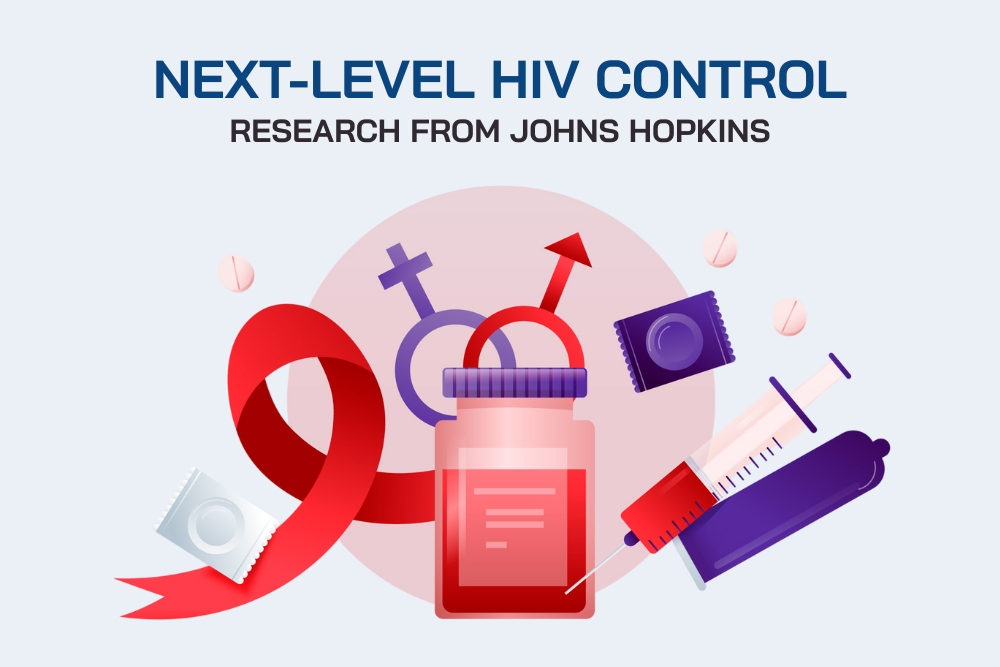Over the past several decades, the fight against HIV—the virus responsible for AIDS—has remained a global challenge. While modern antiretroviral therapy (ART) can now effectively control the amount of virus in the body, allowing people living with HIV to enjoy longer lives and better quality of life, complete HIV control through total viral elimination remains elusive. This is because HIV possesses a unique ability to hide within the body’s cells and reactivate if treatment is stopped.
The latest breakthrough sending waves through the scientific community comes from Johns Hopkins University. Their research has revealed the potential for long-term HIV control using an RNA strand called AST (Antisense Transcript). This may become a key tool in advancing a new treatment approach known as “Block and Lock”—a strategy that aims to force the virus into a permanent latent state, effectively locking it away so it can no longer reactivate.
List of Contents
- HIV Control with Antiretroviral Therapy
- HIV Control with AST
- Laboratory Experiments
- Molecular Mechanism: How Does AST Work?
- The “Block and Lock” Strategy
- Block and Lock vs. Sterilizing Cure
- Policy and Public Health Benefits of AST
- FAQ
HIV Control with Antiretroviral Therapy – Strengths and Limitations
Antiretroviral therapy (ART) remains the most effective standard for HIV treatment today. These medications work by inhibiting the replication process of the virus, reducing the viral load in the body to undetectable levels and allowing the immune system to recover.

However, despite its effectiveness, ART has important limitations:
- It cannot fully eliminate the virus from the body.
- It requires lifelong adherence to daily medication.
- If treatment is interrupted, the hidden HIV virus can quickly reactivate and begin replicating again.
These limitations are the reason why scientists continue to explore new approaches to HIV control—methods that go beyond suppressing the virus, with the hope of achieving a functional cure where people living with HIV may one day live without lifelong medication dependency.
HIV Control with AST – A Solution from the Virus Itself
One of the most promising new approaches to HIV control involves the use of AST (Antisense Transcript)—an RNA strand derived from the HIV genome itself. Unlike typical viral RNA that facilitates protein production, AST plays the opposite role: it inhibits the expression of HIV genes, effectively preventing the virus from replicating or activating. A research team at Johns Hopkins University has hypothesized that AST may have the potential to control viral latency. If scientists can successfully increase the presence of AST within the cells of people living with HIV, it may be possible to “lock” the virus into a deep, permanent state of dormancy—a condition where it remains inactive and cannot reactivate, even without antiretroviral drugs. This mechanism could represent a game-changing breakthrough in the search for a long-term functional cure.
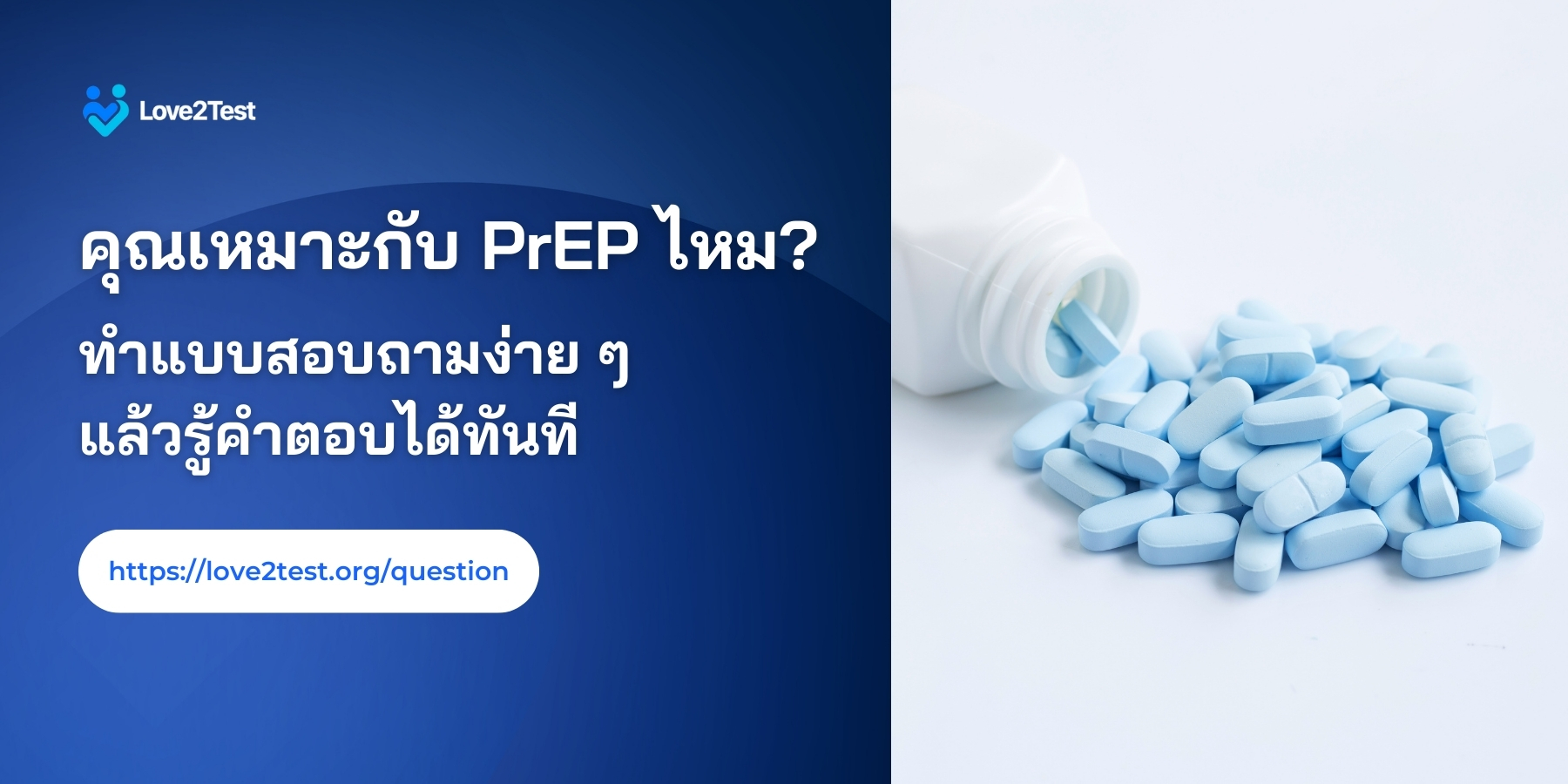
Laboratory Experiments: AST Suppresses HIV Reactivation
To test this hypothesis, the research team conducted experiments using CD4+ T cells—the primary target cells of HIV—taken from people living with HIV who were effectively controlling the virus through antiretroviral therapy. Using genetic engineering techniques, they increased the expression of AST (Antisense Transcript) within these cells.
Next, the researchers exposed the cells to activating agents designed to “wake up” latent HIV and trigger viral replication. They then measured the expression of HIV genetic material. The results were striking:
- Cells expressing AST showed significant suppression of HIV activity.
- Viral reactivation was blocked, unlike in the control group.
- AST maintained viral silence, even when the cells were stimulated externally.
These findings clearly demonstrate that AST plays a critical role in “switching off” the activity of HIV, offering a promising direction for future strategies in long-term HIV control and potential functional cure development.
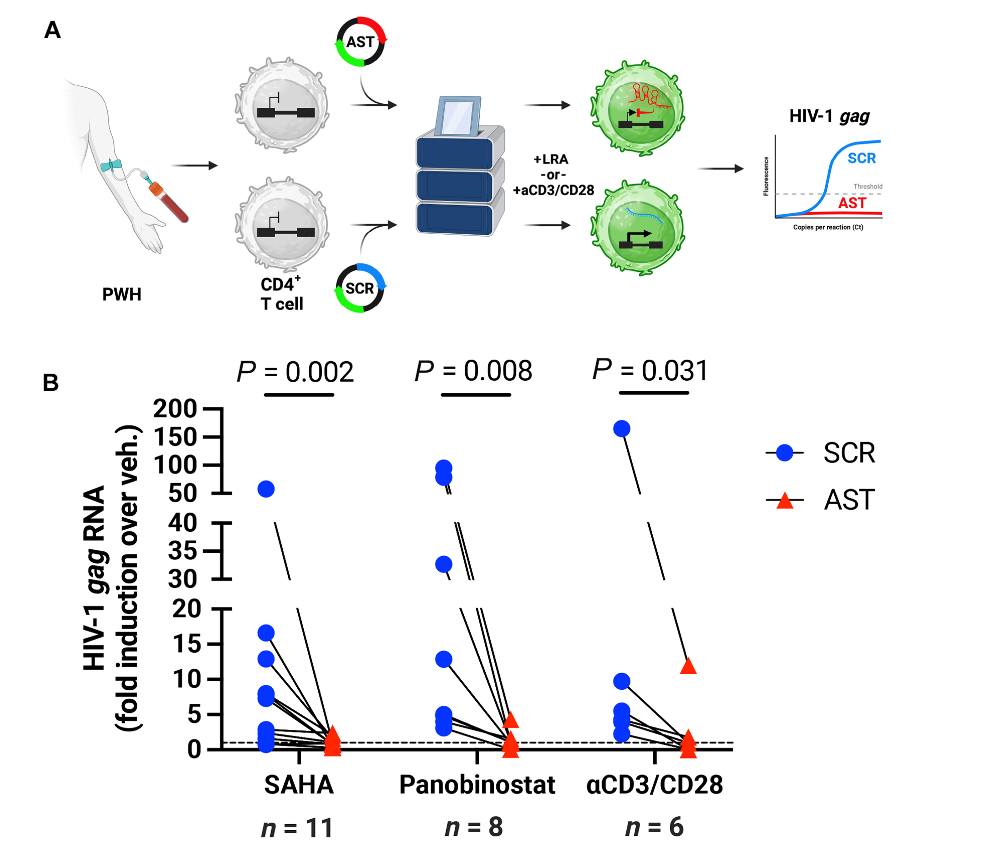
Molecular Mechanism: How Does AST Work?
To better understand the molecular mechanism of AST (Antisense Transcript), researchers explored how it inhibits HIV at the genetic level and uncovered several key findings:
1. Binding to the Viral Gene Control Region (5’ LTR)
AST has specific structural elements that allow it to bind to a critical region of the HIV genome known as the 5’ Long Terminal Repeat (LTR)—the starting point for viral gene expression. By attaching to this site, AST effectively blocks transcription and RNA production, which in turn reduces the amount of viral RNA required for protein synthesis and viral replication. This suppression is a significant step in limiting the virus’s ability to spread and persist.
2. Recruitment of PRC2 Protein Complex
AST also has the ability to recruit the PRC2 complex (Polycomb Repressor Complex 2), a protein group known for its role in chromatin remodeling. PRC2 compacts the chromatin structure surrounding the HIV genome, rendering it inaccessible for transcription machinery. This results in epigenetic silencing—a natural cellular process that permanently shuts down gene activity. By recruiting PRC2, AST doesn’t just block the transcription of viral RNA but also locks down the genome at its root, preventing the virus from reactivating at the molecular level.
3. Reducing the Risk of Viral Rebound
Laboratory studies show that AST significantly reduces the likelihood of viral reactivation, which is a major risk when a patient discontinues antiretroviral therapy. AST helps suppress the re-emergence of HIV from latent reservoirs, preventing the virus from re-entering the replication cycle. This makes AST a promising adjunct to long-term treatment strategies, aimed at maintaining viral suppression without constant reliance on daily ART.
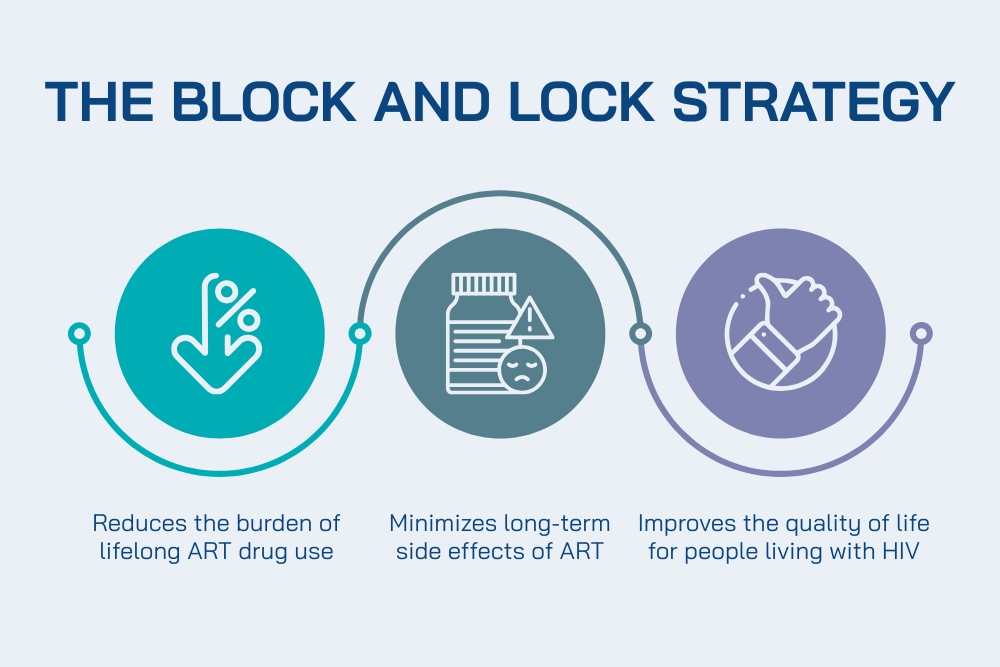
The “Block and Lock” Strategy: A Promising Alternative in HIV Control
The “Block and Lock” approach represents an emerging and promising strategy in HIV control. Unlike traditional treatments that aim to reduce viral load as much as possible, this concept focuses on keeping the virus in a permanent state of dormancy—preventing it from reactivating, rather than attempting to eliminate it entirely. This strategy is not a “sterilizing cure,” which seeks to eradicate every last trace of the virus from the body, but instead aims to disarm the virus, rendering it incapable of damaging the immune system even if it remains present.
Advantages of the Block and Lock Approach:
- Reduces the burden of lifelong antiretroviral drug use
- Minimizes long-term side effects of ART
- Improves the quality of life for people living with HIV
Block and Lock vs. Sterilizing Cure
The sterilizing cure is considered the “holy grail” of HIV treatment—complete viral eradication from the body. However, this remains a distant goal, as it requires the removal of every hidden viral reservoir in every cell, without leaving even a single infected cell behind. In contrast, Block and Lock is viewed as a more realistic, near-term goal. It doesn’t require total eradication of the virus; it simply seeks to lock HIV into a non-active state, allowing individuals to live a normal life without daily medication or risk of viral rebound.
Clinical Hope: AST and Human Trials
Although the use of AST (Antisense Transcript) remains in the experimental stage, its laboratory results have sparked significant optimism. If future human trials confirm that AST is safe and effective, it could usher in a new era of HIV control—one in which lifelong dependence on antiretroviral therapy is no longer necessary.
Policy and Public Health Benefits of AST-Based HIV Control
If AST-based therapies prove scalable and clinically viable, the potential public health impact would be substantial:
- Reduced long-term costs for antiretroviral procurement and distribution
- Lower incidence of opportunistic infections among people with HIV
- Reduced transmission rates, as those with suppressed viral loads pose little to no transmission risk
In addition, deeper viral control may help to combat stigma. When people living with HIV can lead normal, healthy lives without daily medication or fear of transmission, social acceptance and equality become more achievable.
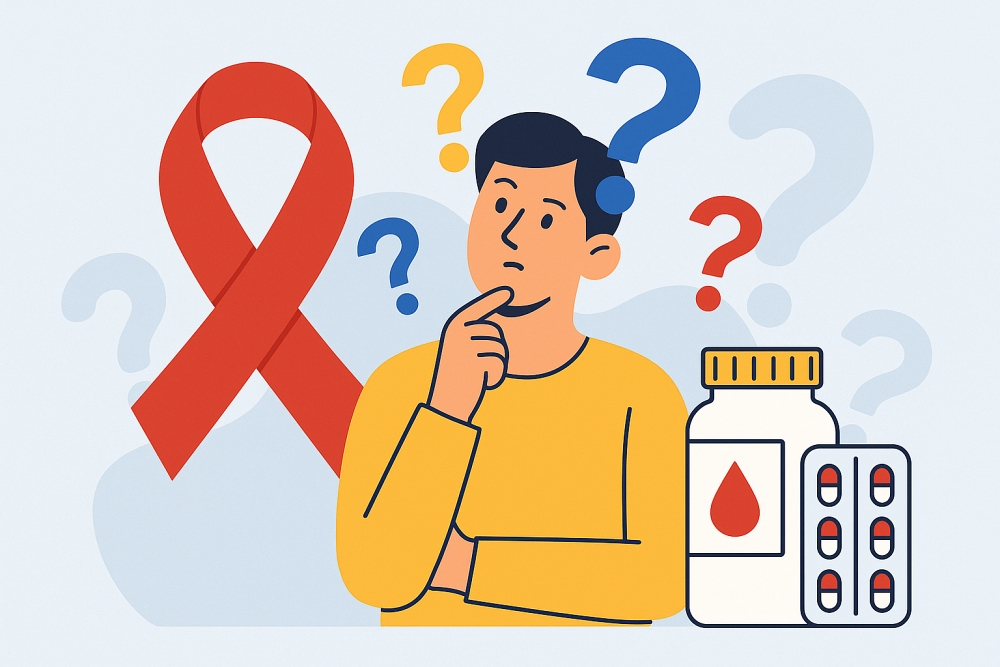
Frequently Asked Questions About HIV Control
= ART (Antiretroviral Therapy) refers to medications that reduce the amount of HIV in the body to undetectable levels. It helps prevent the virus from damaging the immune system and allows people living with HIV to stay healthy and live longer lives.
= Yes. People with HIV should take their medication daily and consistently. Regular adherence helps keep the virus under control and prevents drug resistance. Skipping doses or inconsistent use may cause the virus to become active again.
= Some HIV medications can cause side effects such as nausea, fatigue, rash, or liver issues. However, newer medications are much safer, and doctors can adjust treatment regimens to better suit each individual’s needs.
= Absolutely. With consistent ART, people living with HIV can lead healthy, long lives just like anyone else. They can also have relationships and children without passing on the virus, thanks to effective viral suppression.
= ART is highly effective at controlling HIV, but it does not eliminate the virus from the body. Continuous treatment is necessary. However, new research—such as the use of AST and the “Block and Lock” strategy—is aiming to develop a cure in the future.
= Yes. Thailand has made significant progress in making HIV treatment widely available. Antiretroviral therapy is accessible at public hospitals and clinics across the country, often free or at low cost, thanks to national health policies.
Related Articles
- Unlocking Free HIV Services in Thailand: Testing, PrEP, Treatment
- Innovations in HIV Medication – A Path Towards a Cure
Conclusion: HIV Control Is No Longer Just “Treatment” — It’s a Game Changer
The discovery of AST by the research team at Johns Hopkins is not just another molecular study—it marks the beginning of a new paradigm in HIV control that could transform the lives of people living with the virus around the world. AST represents a shift in thinking: that controlling HIV may not only be about suppressing viral load, but also about understanding the virus’s own mechanisms and turning them against itself.
Looking ahead, we may soon see a world where people living with HIV no longer need daily medication, no longer fear viral rebound, and no longer carry the burden of social stigma—because they are no longer seen as transmitters, but as individuals who have permanently controlled the virus.
Reference:
AST: อาร์เอ็นเอสายลึกลับจาก HIV สู่ความหวังใหม่ในการควบคุมไวรัส
ดร.อนันต์ เผย RNA สายลึกลับจาก HIV ความหวังใหม่ผู้ป่วยโรคเอดส์
- www.thebangkokinsight.com/news/politics-general/general/1490124
เดินต่อไปข้างหน้า ด้วยพลังของชุมชน
- ไทยtga.org/contents?id=370
